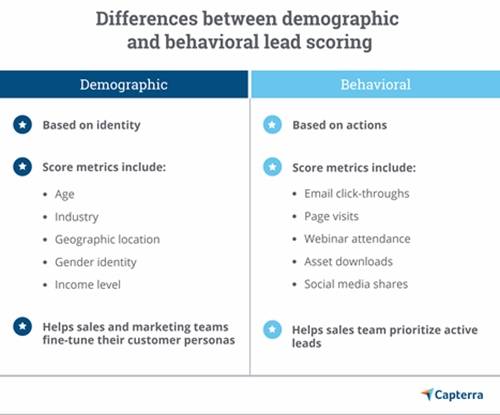Your marketing team works hard producing quality content, fostering an engaging social media presence, and designing eye-catching and actionable campaigns. All to collect quality data on your potential customers.
Why? Because for most marketing teams, the number-one success metric is data on leads.
But as marketers and sales team members alike will tell you, not all leads are created equal. So... how can your marketing team ensure it's passing on only the best, most-qualified leads to the sales team?
With a predictive lead-scoring strategy.
Predictive lead scoring can help your marketing team identify which leads are likely ready to close and should be passed to the sales team, and which ones should remain with Marketing in the nurture track.
So, let's...
- Debunk some common misconceptions about lead scoring
- Take a look at what goes into a lead-scoring model
- Equip you with the tools you'll need to increase your leads' quality and boost marketing ROI
1. Two Truths and a Lie: What You Need to Know About Lead Scoring
When your company's bottom line is at stake, discussions around leads can get pretty heated. Who's responsible? Who gets the credit? Who gets the blame?
By clearing up a couple of common misconceptions, we can make a potentially rocky path smooth and move forward more surefootedly.
Here are some common, misguided ideas about gathering and scoring leads, along with some best-practices to adopt today:

Those are just a few of the common misconceptions that can cripple your marketing and sales teams with unreliable lead data. The good news is that there are some easy, best-in-class practices that your teams can adopt today.
Some of those best practices are outlined above, such as how your sales and marketing teams will mutually benefit from frequent collaboration. Above all else, though, how you score your leads will determine the success of leads passed from Marketing to Sales.
2. Scoring Your Leads: Who They Are and What They Do
There are two primary types of lead scoring: demographic and behavioral.
In determining buyer intent, predictive lead-scoring models that incorporate both kinds of data provide a significant upgrade over the traditional, engagement-driven lead scoring models.
Demographic scoring indicates whether—based on your company's key customer personas—a lead is likely receptive to what your product/service has to offer. Your marketing team should have persona-specific content ready to send out based on a lead's demographic score.
Behavioral scoring tracks and scores a lead's actions, such as visiting a webpage, downloading a whitepaper, or opening an email. This type of scoring provides important distinctions between lead activities, allowing you to pursue the ones that matter most (a visit to your pricing page is a much stronger indicator of a good lead than a visit to your careers page).
Here's a breakdown of these two lead-scoring metrics:

Equipped with a holistic approach to lead scoring, you're ready to tackle the third problem: What tools can best make use of your predictive lead-scoring results?
3. Tools of the Lead-Scoring Trade
By observing and scoring the attitudes and actions of your potential customers, you have all the information you need to decide the best follow-up action for each individual lead.
- Have your predictive-lead scores indicated a lot of very interested prospects who are ready to buy? Great! Pass those future customers on to your sales team. Job well done.
- Did your predictive-lead scores indicate customers who are a good fit for your product/service but aren't quite ready to buy? Also great! Those are the leads you should focus your marketing attention on.
- What about if your predictive-lead scores indicated some leads who might not be a good fit and aren't ready to buy yet? You've identified a group of folks who are very unlikely to convert to customers. Use this information to fine-tune your buyer personas and segment these people out.
As a marketer, the customers in your sweet spot are the second group listed above: customers who are a good fit for your product/service but aren't quite ready to buy.
Take a look at these leads and the information you've gathered from your interactions with them so far. Where were they willing to engage with you? What motivated them to interact? Where in the buyer's journey are they? Each of those data points should inform how you next reach out to these leads, and which marketing tool you use to do so.
There are a ton of tools in the marketing professional's toolbox that you can utilize to bring those leads closer to a "ready-to-buy" mindset. Here are just a few options:
- Lead nurturing software. Cutting right to the chase? Lead nurturing software comes with tools that will help you move leads down the sales funnel. Prioritize software solutions that allow you to segment your leads and personalize your communication with them.
- Marketing automation software. Do you have a small team with a lot of leads? Marketing automation software can help you automate and personalize the marketing processes from end-to-end. Look for software that allows you to break down and specify unique follow-up actions for every step of the buyer's journey.
- Social media marketing software. Is your business thriving on social media? Social media marketing software is a great option if you do your most effective interacting on social platforms. Be sure the solution you choose offers conversion tracking and customizable targeting for different customer segments.
Happy Leads Become Happy Customers
Predictive-lead scoring is a net benefit for everyone.
Customers are both happier and more likely to shop with brands that offer personalized communication and provide offers relevant to them. Your sales team is set up for success with strategically vetted leads who are more likely to convert. Your marketing team can spend its time and energy nurturing high-value leads who are more likely to respond positively to outreach.




